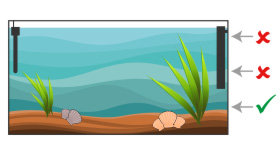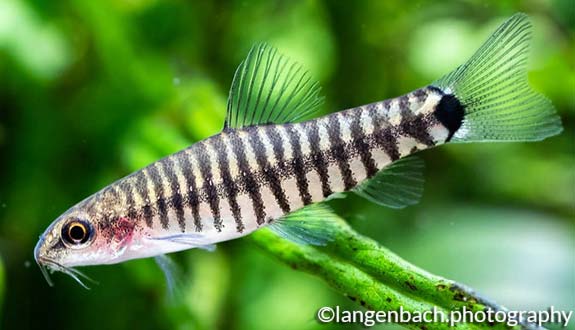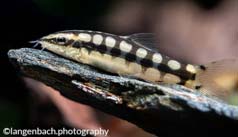

Alternative species (click on the thumbnail to see the card)
Names
Scientific name
Yunnanilus cruciatus
Yunanilus cruciatus (faute)
Nemacheilus cruciatus
Micronemacheilus cruciatus
Nemacheilus cruciatus
Common name
Vietnamese Multi Banded
Hovering Zebra Loach
Laos Pygmy Multi-Stripe Loach
Origin

Origin: Southeast Asia (Vietnam)
Biotope: Asian
Dimorphism

Females are slightly larger than males and have a rounded belly.
Group

Nemacheilidae
Volume

80 L / 18 imp gal / 21 US gal
Parameters

T°: 25 to 28°C or 77 to 82°F
pH: 6 to 7
Hardness: 2 to 10°dGH
Difficulty

Average
Size

3 to 3.5cm (1.2 to 1.4")
Longevity

2 to 4 years
Living zone

Depth
Individuals

8
Food
How to feed the Yunnanilus Cruciatus?
Food
How to feed the Yunnanilus Cruciatus?
This little fish is not very difficult to feed. Hand out small live (or if not frozen) prey. On the menu: artemia nauplias, cyclopses, daphnia etc... You can also gradually get him used to powdered commercial food or bottom pellets. In any case, you can count on the variety of prey on offer.
Behavior
What kind of behavior does the Yunnanilus Cruciatus have?
Behavior
What kind of behavior does the Yunnanilus Cruciatus have?
This little locust is quite lively and active, it is always on the move. It lives mainly at the bottom of the aquarium, but does not hesitate if it feels comfortable in its tank swimming in the open water with the other fish.
Some observations show that cruciatus loches become more shy and discreet as they grow older, they would hide more often.
Cohabitation
Who can live with the Yunnanilus Cruciatus?
Cohabitation
Who can live with the Yunnanilus Cruciatus?
The Yunnanilus needs the presence of many congeners to feel good because it has a developed gregarious instinct. Thus, it lives in captivity in groups of at least 8 to 10 individuals, but the more numerous they are, the happier they are! An isolated individual is more prone to disease and to an alteration of his natural behaviour.
For other species of fish, this small loach does not pose a particular problem. However, the risk of predation by large fish should be noted.
In general, prefer to associate it with fish of the same size and temperament as its own. For example (non-exhaustive list): small cyprinids (Microdevario, Boraras, Trigonostigma heteromorpha, Tanichthys, Microrasbora, Danio erythromicron, Danio margaritatus...) or other small fishes of the characidae family.
Breeding
How to breed the Yunnanilus Cruciatus?
Breeding
How to breed the Yunnanilus Cruciatus?
Parents don't take care of their eggs at all, and worse: they eat them! So it can be difficult to raise fry with their parents. However, spontaneous reproduction in a mature aquarium with a high plant density remains possible. For the best chance of having young, it is better to go through a more defined protocol on which you can intervene.
For this, prepare several small tanks (10 to 15 litres will suffice) with aged water. Install a good portion of mop or moss type vegetation (Taxiphyllum for example). Lighting and filter are not necessary, although a small sponge filter can do no harm.
Condition the parents by giving them live prey... When the females are well bellied, introduce one brood per tray (you can introduce more, but predation increases as well).
After a parade initiated by the male, the eggs are released one by one and deposited on leaves or on the glass of the aquarium. Remove the parents immediately after laying to save as many eggs as possible.
Feeding the fry: infusing then nauplias of artemia.
Its aquarium
Which aquarium for the Yunnanilus Cruciatus?
Its aquarium
Which aquarium for the Yunnanilus Cruciatus?
Water quality is important. This species prefers slightly acidic water (pH below 7) and soft water (hardness below 10). On the other hand, the tolerance range for temperature is more reasonable, with an average ideal temperature between 25 and 28°C. Finally, this fish will appreciate a good current and well oxygenated water. To do this, install a powerful filter (flow rate of 10 to 20 times the volume of the tank per hour).
Concerning the decoration, it is imperative to provide a fine and loose sandy soil. The sand must also be smooth (non-sharp edges) in order to preserve its barbs and avoid injury. The ground should be littered with rocks and pebbles, and why not with a few dead leaves.
As for light, too bright lighting can intimidate the Yunnanilus. Keep the light as low as possible, for example with the help of vegetation (floating plants for example).
Plant your aquarium densely.
Good To know
Find all additional information!
Good To know
Find all additional information!
Highly sensitive to transport, acclimatization will be a crucial step in the rest of their maintenance. Acclimatize very gently and slowly. After this period, the Yunnanilus is quite robust.
It feeds thanks to its 4 barbels (2 pairs). These are sensory organs that allow it to detect its food in by stirring the ground.
Yours photos!
Comments
Sort by:
Please login to post comments


